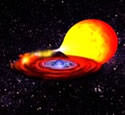
Image credit: ESA
Shortly after the Big Bang, it’s believed that all the matter in the Universe was broken up into its smallest components. But astronomers believe that some of this original material may be created again inside very dense neutron starts. Using the XMM-Newton space telescope, a team of astronomers are attempting to calculate the “compactness” of several neutron stars – to see if they go beyond the density of normal matter.
A fraction of a second after the Big Bang, all the primordial soup of matter in the Universe was ‘broken’ into its most fundamental constituents. It was thought to have disappeared forever. However scientists strongly suspect that the exotic soup of dissolved matter can still be found in today’s Universe, in the core of certain very dense objects called neutron stars.
With ESA’s space telescope XMM-Newton, they are now closer to testing this idea. For the first time, XMM-Newton has been able to measure the influence of the gravitational field of a neutron star on the light it emits. This measurement provides much better insight into these objects.
Neutron stars are among the densest objects in the Universe. They pack the mass of the sun inside a sphere 10 kilometres across. A sugar cube-sized piece of neutron star weighs over a billion tonnes. Neutron stars are the remnants of exploding stars up to eight times more massive than our Sun. They end their life in a supernova explosion and then collapse under their own gravity. Their interiors may therefore contain a very exotic form of matter.
Scientists believe that in a neutron star, the density and the temperatures are similar to those existing a fraction of a second after the Big Bang. They assume that when matter is tightly packed as it is in a neutron star, it goes through important changes. Protons, electrons, and neutrons ? the components of atoms – fuse together. It is possible that even the building-blocks of protons and neutrons, the so-called quarks, get crushed together, giving rise to a kind of exotic plasma of ‘dissolved’ matter.
How to find out? Scientists have spent decades trying to identify the nature of matter in neutron stars. To do this, they need to know some important parameters very precisely: if you know a star?s mass and radius, or the relationship between them, you can obtain its compactness. However, no instrument has been advanced enough to perform the measurements needed, until now. Thanks to ESA’s XMM-Newton observatory, astronomers have been able for the first time to measure the mass-to-radius ratio of a neutron star and obtain the first clues to its composition. These suggest that the neutron star contains normal, non-exotic matter, although they are not conclusive. The authors say this is a ?key first step? and they will keep on with the search.
The way they got this measurement is a first in astronomical observations and it is considered a huge achievement. The method consists of determining the compactness of the neutron star in an indirect way. The gravitational pull of a neutron star is immense – thousands of million times stronger than the Earth?s. This makes the light particles emitted by the neutron star lose energy. This energy loss is called a gravitational ‘red shift’. The measurement of this red shift by XMM-Newton indicated the strength of the gravitational pull, and revealed the star?s compactness.
“This is a highly precise measurement that we could not have made without both the high sensitivity of XMM-Newton and its ability to distinguish details,” says Fred Jansen, ESA’s XMM-Newton Project Scientist.
According to the main author of the discovery, Jean Cottam of NASA?s Goddard Space Flight Center, “attempts to measure the gravitational red shift were made right after Einstein published the General Theory of Relativity, but no one had ever been able to measure the effect in a neutron star, where it was supposed to be huge. This has now been confirmed.”
Original Source: ESA News Release
